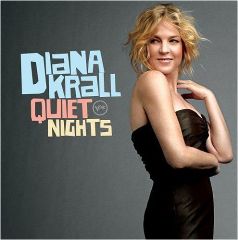Diana Krall – Quiet Nights (2009)
Diana Krall – Quiet Nights (2009)

01. Where Or When 4:10 02. Too Marvelous For Words 4:05 03. I've Grown Accustomed To His Face 4:48 04. The Boy From Ipanema 4:54 05. Walk On By 5:03 06. You're My Thrill 5:47 07. Este Seu Olhar 2:46 08. So Nice 3:52 09. Quiet Nights 4:45 10. Guess I'll Hang My Tears Out To Dry 4:59 11. How Can You Meand A Broken Heart (Bonus Track) 4:30 12. Every Time We Say Goodbye (Bonus Track) 5:19 Personnel: Joel Pargman, Eun Mee Ahn, David Ewart, Amy Wickman, Gil Romero, Katia Popov, Tammy Hatwan, Alan Grunfeld, Helen Nightengale, Barbara Porter, Mari Tsumura, Razdan Kuyumjian, Sid Page, Bruce Dukov, Peter Kent, Yue Deng, Tiffiany Yi Hu, Darius Campo, Liane Mautner, Josephina Vergara, Caroline Campbell, Charlie Bisharat, Mario Diaz de Leon, Tereza Stanislav (violin); Matt Funes, Dan Neufeld, Todd Marda, Victoria Miskolczy, Marlow Fisher, Kate Reddish, Janet Lakatos, Dave Walther, Evan Wilson, Thomas Dienner (viola); Trevor Handy, Rudy Stein, Timothy Landauer, Dan Smith , Vanessa Freebairn-Smith, Antony Cooke , Larry Corbett, Cecilia Tsan, Steve Richards (cello); Heather Clark, Steve Kujala, Geri Rotella, David Shostac (alto flute, bass flute); Earl Dumler (oboe); Joseph Meyer , Todd Miller, Bill Lane, Rick Todd, Brad Warnaar (French horn); Doug Tornquist (tuba); Robert Zimmiti (vibraphone); Drew Dembowski, Reggie Hamilton, Sue Raney, Nico Abondolo, Ed Meares (bass guitar).
Diana Krall’s Quiet Nights (Verve) contains laid-back bossa novas and crawling ballads, colored with Claus Ogerman’s delicate orchestral arrangements. Unfortunately, beyond the lush ensemble sound and the creaminess of Krall’s voice, saturated with sultriness, there is not much the album has to offer.
The focus throughout is timbre, at the expense of meaningful solos, interesting harmonies, or rhythmic contrast. The album uses the bossa nova style coined by Antonio Carlos Jobim as its unifying element, but hardly adds anything innovative or personal to it. Quiet Nights would serve wonderfully as background music because it never strays from its whispery, steamy territory. To listen to it closely, as opposed to letting it merely provide the backdrop for a romantic scene, is to risk suspending consciousness.
Krall, a gifted pianist as well as a singer, punctuates her vocal performances with brief piano interludes. These solos, just about the only instances of improvisation on the album, don’t do much to shake things up, but fall right into the hazy, dreamy scheme of the record. Each solo is precious and simple, played exclusively in the piano’s upper register, invoking the nostalgic and somewhat maudlin sound of a music box.
The slow, hushed tone of Quiet Nights is one that Diana Krall, with her silky voice and pop sensibility, could use to sculpt something beautifully intimate. However, intimacy, although approached constantly, is never actually reached. A good vocal performance can evoke subtle emotions, and can draw the listener in a unique way. Instead, Krall’s evocations sound manufactured and deliberate.
This may be in part due to Ogerman’s luscious backgrounds. As I wrote in my review of Danilo Perez’ Across the Crystal Sea, for which Ogerman also arranged flowery string accompaniment, the backgrounds are restrictive. For Perez, they limited his ability to freely establish moods through his harmonic and technical prowess. Krall is also restricted by the backgrounds, which are long and sustained without exception. The orchestra’s chords crowd out the brilliance of her voice.
For people who want nothing more from music than to provide lovely background music that requires little attention, Quiet Nights is perfect. For those who would like something more, this record should be overlooked in wait for something of Krall’s that is more honest and expressive. --- Jacob Teichroew, jazz.about.com
download (mp3 @320 kbs):
uploaded yandex 4shared divshare mediafire mega solidfiles zalivalka cloudmailru filecloudio anonfiles oboom
Zmieniony (Poniedziałek, 08 Wrzesień 2014 16:06)








